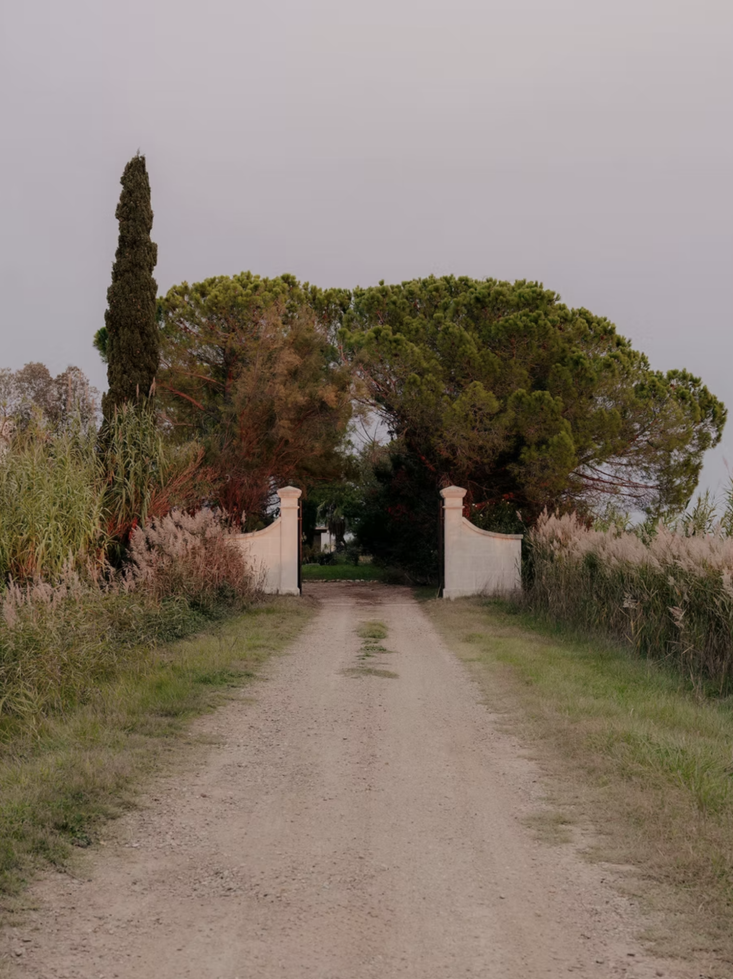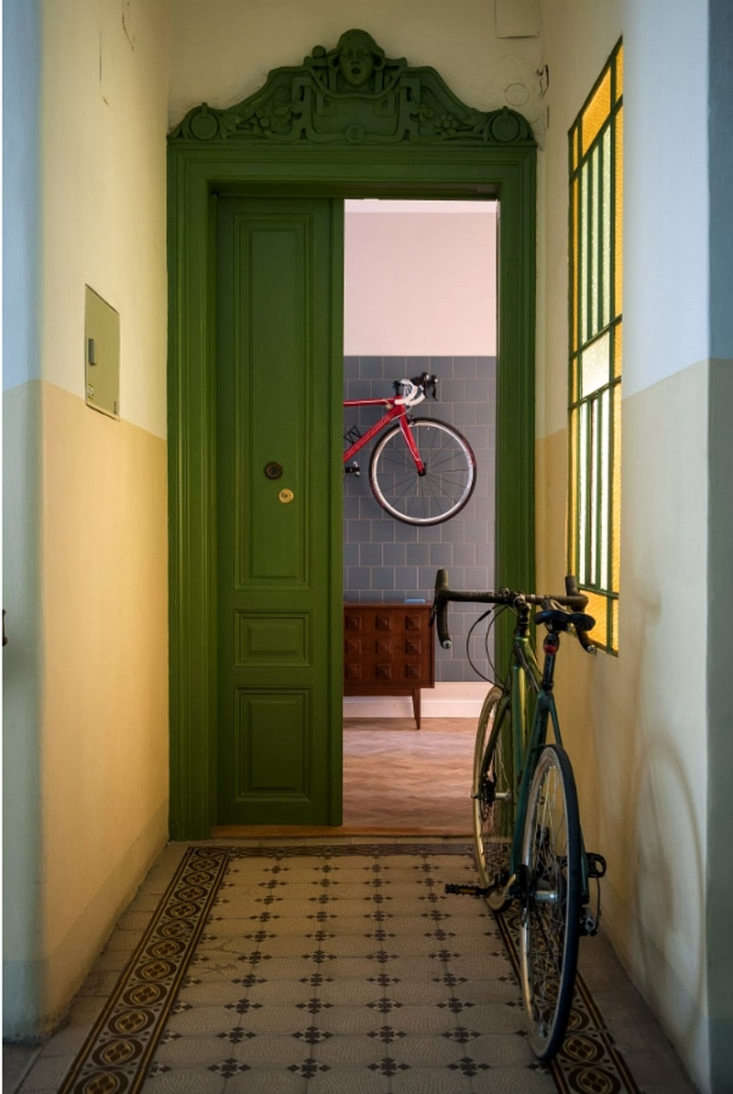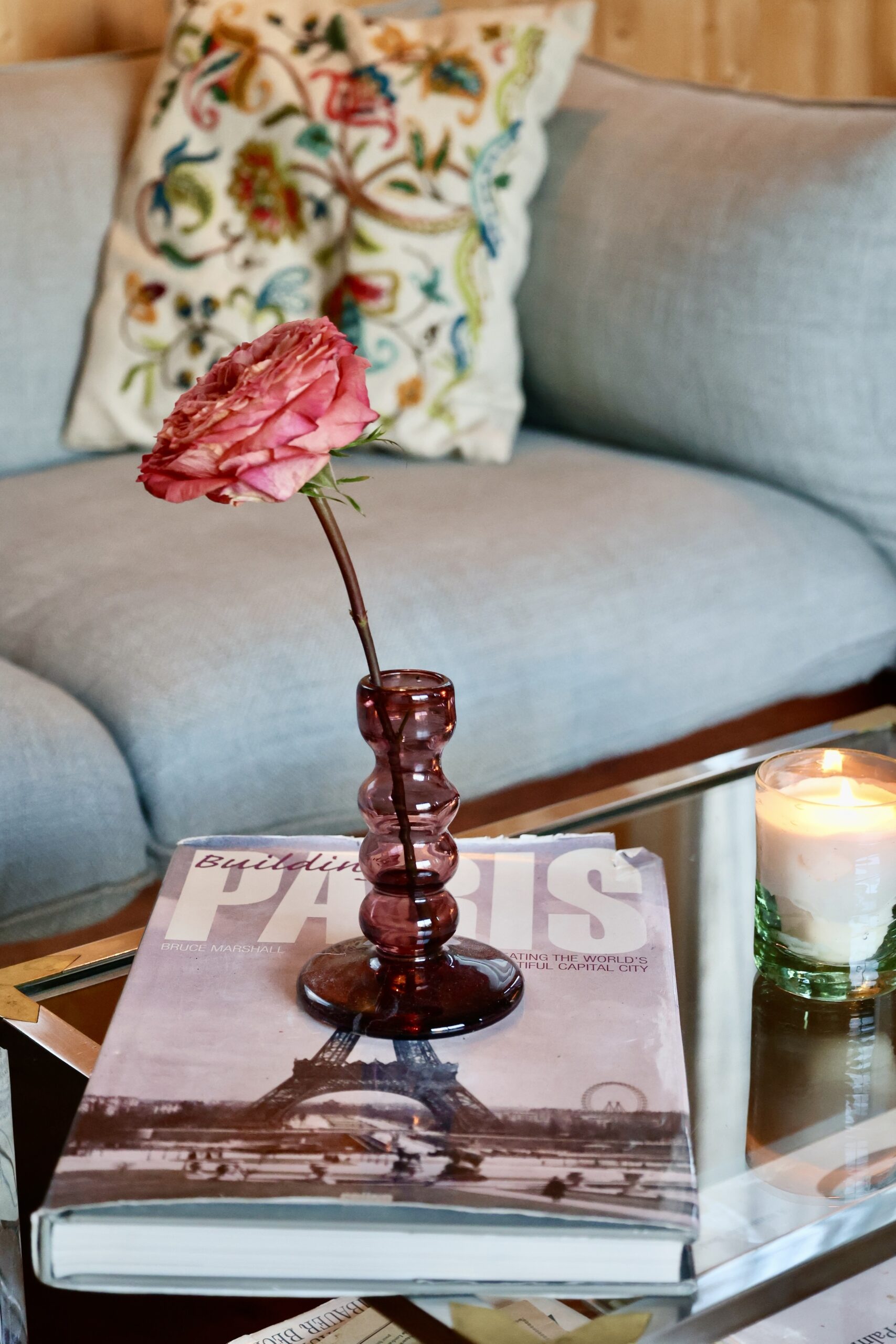Architects Caroline Weill and Letitia Paradis of the Paris-based practice Pareil focus on housing in all forms, aiming to “enhance existing properties with a modest and responsible approach to architectural intervention and application,” as they explain. One such property is Mas Baudran, an artist residence located in the commune of Arles in southern France. Situated at the edge of the Parc naturel régional de Camargue, along the Mediterranean, the 2.5-acre agricultural estate faces climate risks of rising water levels and salinization of groundwater. The resulting renovation from Pareil is both elegant and modern, achieving thermal efficiency, reducing carbon emissions, and preserving resources. Read on for more.
Photography by Jean-Baptiste Thiriet courtesy of Pareil.
Above: The entrance to the agricultural estate in Arles.
Owners Sébastien, an environmental lawyer, and Sofian, a hairstylist-turned-ceramicist, moved permanently from Paris to the Arles farmhouse in 2021. Sofian had been the hairstylist for both Weill and Paradis before enlisting their practice for the project. The initial request was to renovate the house. “They were looking for more bedrooms, more space to entertain, an office for Sébastien’s remote work, and a ceramics workshop for Sofian’s own training,” Weill explains.
 Above: Successive historical layers make up the farmhouse. The original building, typical of Camargue’s agricultural heritage, dates back to the 16th century.
Above: Successive historical layers make up the farmhouse. The original building, typical of Camargue’s agricultural heritage, dates back to the 16th century.
The owners knew from the start that the property would function as more than just their residence, and would be centered around environmental sustainability. The Mas Baudran artist residency project emerged as the initial plans were drawn. Their aim is to raise awareness and engage the general public on issues related to environmental preservation and climate protection through artistic creation, agroecology, and the interdisciplinary exchange among artists, lawyers, scientists, and activists. The artist residency includes a reception room, ceramics workshop, a multipurpose room for resident artists, and a main bedroom.
 Above: Historic stonework meets modern additions from previous renovations. Pareil preserved original stone with a lime whitewash and finished other surfaces with white paint. The shutters were either preserved or renovated to match.
Above: Historic stonework meets modern additions from previous renovations. Pareil preserved original stone with a lime whitewash and finished other surfaces with white paint. The shutters were either preserved or renovated to match.
As the house is located within the Parc naturel régional de Camargue, all modifications were tightly controlled. They achieved thermal efficiency without the use of air conditioning and installed a heat pump for radiant heating. Solar panels were installed to the roof and insulated the roof using rice straw from the surrounding Camargue region, chosen for its insulating properties and local, low-impact origin. The straw is dried, lightly compacted (10-centimeter slats), and inserted between timber framing elements in the roof before being protected with a breathable membrane to ensure durability and to prevent moisture issues.
 Above: The architects replaced all windows throughout the farmhouse to improve insulation.
Above: The architects replaced all windows throughout the farmhouse to improve insulation.
In order to protect from the salinity of the area, a deep well was installed to avoid salt water reaching fresh drinking water and either a lime coating or lime whitewash was applied to exterior surfaces to protect from salt air.
 Above: The floor-to-ceiling glass door mirrors the dimensions and axis of the original barn entry. When opened, it emphasizes the continuity between indoor and outdoor space.
Above: The floor-to-ceiling glass door mirrors the dimensions and axis of the original barn entry. When opened, it emphasizes the continuity between indoor and outdoor space.
 Above: The furniture throughout the farmhouse belongs to the clients and is primarily vintage or secondhand.
Above: The furniture throughout the farmhouse belongs to the clients and is primarily vintage or secondhand.
 Above: The wall-to-wall counter, integrated along a large window, is designed in tinted ash.
Above: The wall-to-wall counter, integrated along a large window, is designed in tinted ash.
 Above: The flooring is anhydrite screed used to cover radiant heating. The architects intentionally left it uncovered, instead finishing it in flaxseed oil for protection.
Above: The flooring is anhydrite screed used to cover radiant heating. The architects intentionally left it uncovered, instead finishing it in flaxseed oil for protection.
 Above: A view through the kitchen to the staircase beyond.
Above: A view through the kitchen to the staircase beyond.
 Above: The architects integrated a buffer space—a patio bioclimatique—between interior and exterior areas to provide more shade in the summer and protect against the direct heat of the southern sun.
Above: The architects integrated a buffer space—a patio bioclimatique—between interior and exterior areas to provide more shade in the summer and protect against the direct heat of the southern sun.
 Above: The staircase was custom-designed for the space. “As it is very visible from the common space, the idea was that it had to be compact, elegant, sculptural, but discrete,” Weill describes. “The curved form achieves that.”
Above: The staircase was custom-designed for the space. “As it is very visible from the common space, the idea was that it had to be compact, elegant, sculptural, but discrete,” Weill describes. “The curved form achieves that.”
 Above: A detailed view of the tinted ash construction.
Above: A detailed view of the tinted ash construction.
 Above: The stairwell as seen from the upper floor.
Above: The stairwell as seen from the upper floor.
 Above: A view into the main upstairs bedroom.
Above: A view into the main upstairs bedroom.
 Above: An integrated alcove shelf serves as bedside storage.
Above: An integrated alcove shelf serves as bedside storage.
 Above: The upper level includes a flexible lounge space designed for reception, yoga, film screenings, or work space.
Above: The upper level includes a flexible lounge space designed for reception, yoga, film screenings, or work space.
 Above: A series of casement windows.
Above: A series of casement windows.
 Above: The void is a double-height space above the ceramics studio; the curtain improves acoustics.
Above: The void is a double-height space above the ceramics studio; the curtain improves acoustics.
 Above: At one end of the farmhouse, a humble ceramics studio for owner Sofian.
Above: At one end of the farmhouse, a humble ceramics studio for owner Sofian.
 Above: The surrounding rice fields of the estate.
Above: The surrounding rice fields of the estate.
For more renovations with sustainability in mind, see our posts:



